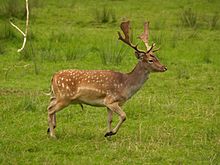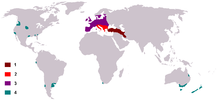Fallow Deer
| Fallow deer | |
|---|---|
 |
|
| Male (buck) | |
 |
|
| Female (doe) | |
| Scientific classification | |
| Kingdom: | Animalia |
| Phylum: | Chordata |
| Class: | Mammalia |
| Order: | Artiodactyla |
| Family: | Cervidae |
| Subfamily: | Cervinae |
| Tribe: | Cervini |
| Genus: |
Dama Frisch, 1775 |
| Species: | D. dama |
| Binomial name | |
|
Dama dama (Linnaeus, 1758) |
|
 |
|
| Range 1: Native 2: Possibly native 3: Early human introductions and reintroductions 4: Modern human introductions |
|
The fallow deer (Dama dama) is a ruminant mammal belonging to the family Cervidae. This common species is native to western Eurasia, but has been introduced to Antigua & Barbuda, Argentina, South Africa, Fernando Pó, São Tomé, Madagascar, Mauritius, Mayotte, Réunion, Seychelles, Comoro Islands, Morocco, Algeria, Tunisia, Cyprus, Israel, Cape Verde, Lebanon, Australia, New Zealand, Canada, the United States, the Falkland Islands and Peru. Some taxonomers include the rarer Persian fallow deer as a subspecies (D. d. mesopotamica), while others treat it as an entirely different species (D. mesopotamica).
The male fallow deer is known as a buck, the female is a doe, and the young a fawn. Adult bucks are 140–160 cm (55–63 in) long with a 85–95 cm (33–37 in) shoulder height, and typically 60–100 kg (130–220 lb) in weight; does are 130–150 cm (51–59 in) long with a 75–85 cm (30–33 in) shoulder height, and 30–50 kg (66–110 lb) in weight. The largest bucks may measure 190 cm (75 in) long and weigh 150 kg (330 lb). Fawns are born in spring at about 30 cm (12 in) and weigh around 4.5 kg (9.9 lb). The life span is around 12–16 years.
...
Wikipedia

